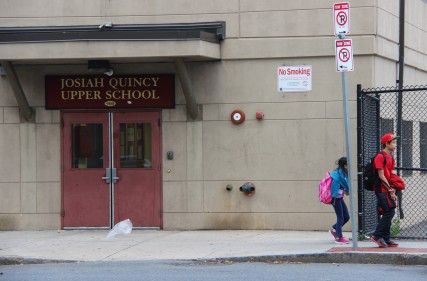
Planning to build the most expensive public school project in Massachusetts, the city of Boston proposed on Oct. 1 the construction of a shared building for two Boston Public Schools.
Brian Ballou, director of media relations for Boston Public Schools, said the proposal will combine the Quincy Upper School and the Boston Arts Academy for a cost of $261 million.
“It makes total sense,” he said. “For more than a decade, both schools have been looking for a solution to their building problems or lack of space at their current site … For over 10 years, the leaders of both schools have been looking for a viable site.”
The Boston Arts Academy, located in a former post office warehouse in Fenway, shares its space with Fenway High School, a building that news outlets have reported lacks the space and utilities needed for a visual and performing arts high school. The Quincy Upper School has also expressed

the need to either expand or improve their building in Bay Village.
Interim Superintendent John McDonough said this project would create a much-needed home base for two important Boston public schools between Chinatown and the Theater District.
“This solution would connect Boston Arts Academy to the city’s Theater District and maintain the link between Quincy Upper and Chinatown,” he said in a Monday statement. “It would also allow these successful schools to welcome more students while freeing up much-needed elementary school space for downtown families, which is now being used by a high school.”
This new school has been an important topic in the upcoming mayoral election as both candidates are focused heavily on education reform.
City Councilor John Connolly, who came second in the Sept. 24 primary after Mass. Rep. Martin Walsh, said he agrees with the proposal and hopes it moves forward.
“Students at the Boston Arts Academy and the Quincy Upper School have been waiting for years for the new school facilities they deserve,” he said in an Oct. 1 statement. “Although the state will reimburse a portion of these costs, it is well past time that the BPS showed how it intends to complete and pay for these important school building projects by producing a comprehensive long-term facilities plan.”
Walsh said he wanted to suggest a different plan to address the current need of public schools.
“Projects like these require a robust public process as well as a look at how projects fit into the larger plan to ensure that every child in Boston has a great school to attend,” he said in a statement on Oct. 1. “I understand there is a need for upgraded facilities, and I have a 10-year, $1 billion plan that addresses that need.”
Both schools would retain their own identities upon the completion of the building, but would share many of the same commodities, news outlets reported. The administrative offices, cafeteria and athletic space would be shared rather than spending more money on two separate buildings.
Boston Municipal Research Board President Samuel Tyler said the cost of the building would not have a significant financial burden on taxpayers.
“These are 30-year bonds for the city that would be paid off over time, and this would be a permanent structure that would certainly serve the public that long [30 years] and longer,” he said.
Some residents said they were skeptical about the plan being the best choice for BPS.
John Moy, 56, resident of Boston, said this follows a high spending trend in schools all over Massachusetts.
“That is a lot of money, but a lot of the suburban high schools have been spending that kind of money too, like Newton North [High School],” he said. “I know some people were pretty upset about it, but they did get a nice school.”
Carla Casey, 49, resident of Hyde Park, said if the project will benefit Boston, they should break ground soon.
“The idea of combining the two [schools] is not that great of an idea,” she said. “[But] if that’s what they need to make our younger generation stronger and smarter and it’s going to help out our economy, then give them the money.”
Christopher Malenfant, 44, resident of Brookline, said although the money should go toward education, he is not sure if this is the best option for BPS.
“I’m all in favor of spending money on education, so I like the idea of our money being spent for it,” he said. “I wonder if it’s going to be the most effective use of the money given towards the overall situation of education in the Boston area. It’s a tough call.”






















































































































